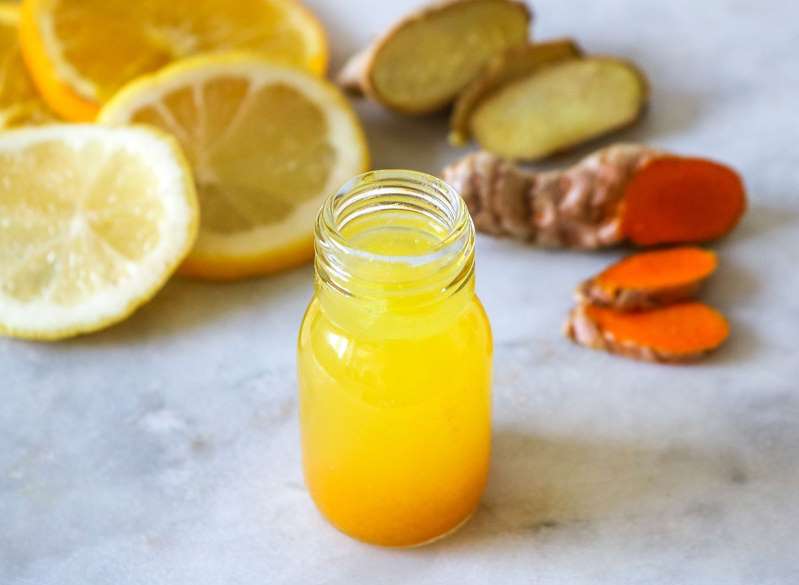Fire cider recipe
Ingredients
1/4 cup freshly chopped garlic
1/4 cup freshly chopped ginger
1/4 cup freshly chopped horseradish
2 dried hot chiles, crushed (freshly chopped will also work)
1 Tbsp ground or freshly grated turmeric
1/2 tsp black peppercorns, crushed
1 orange, washed and quartered
1 lemon, washed and quartered
Apple cider vinegar
Honey
How To Make It
Combine garlic, ginger, horseradish, chiles, turmeric, and peppercorns in a clean quart-sized jar. Squeeze orange and lemon into the mixture and add the rinds. Stir well, then press the solids down to firmly pack them.
Pour in apple cider vinegar until the solids are completely covered (but don't fill the jar to the brim). If your jar's lid is metal, cover the top with a square of parchment paper before tightly sealing the lid—metal can react weirdly with vinegar, and no one wants that.
For quick cider: Transfer the jar to the fridge and let it steep for at least 12 hours. Use a wooden spoon to press down on solids to extract as much flavor as possible. Pour about 1 shot of the cider and mix in honey to taste. Take a shot (or a half-shot) every morning or whenever you feel under the weather. Finish within 1 month.
For OG slow cider: Transfer the jar to a cool, dark area in the kitchen, like a pantry or cabinet. Let the mixture steep, gently shaking the jar daily for three weeks. Use a wooden spoon to press down on the solids to extract as much flavor as possible, then strain out the solids and mix in honey to taste. Discard the solids and transfer the cider to the fridge. Take a shot (or a half-shot) every morning or whenever you feel under the weather. Finish within 1 month.
Any time I feel under the weather, I make a large batch of fire
cider, an immune-boosting tonic of acidic, spicy things like garlic, ginger,
horseradish, chiles, and apple cider vinegar, mixed with fresh citrus juice and
honey. I take little shots of it throughout the day, letting its healing warmth
run through my body.
©
Provided by Eat This, Not That! immune-boosting shot
Similar in flavor to a shrub or a switchel, fire cider is often
relied upon by herbalists to stop flu and cold symptoms in their tracks. Though
a quick version can be mixed up overnight, a proper batch of fire cider takes a
few weeks to brew.
As we work through daily life doing our best to prevent the
spread of the novel coronavirus,
a combined effort to practice social distancing means you'll have plenty of
time to make a big batch of this fire cider. Or make a quick batch for now
and an OG slower batch to freeze for later.
And for more quarantine ideas, don't miss these 20 Healthy Foods to Add To Your Coronavirus Grocery List.
What are the health
benefits of fire cider?
The spicy components of the drinking aid in decongestion and warm
the body; citrus brings immune-boosting vitamin C, while garlic
and honey offer antibacterial support. Some believe strongly in the
antiviral properties of these ingredients, but as much less research
has been produced in that area, put only some of your faith in fire cider. The
drink will still soothe a sore throat, clear your sinuses, and warm you to
your core.
Though humans have made strong brews with natural ingredients to combat illness for generations, the actual term "fire cider" is widely attributed to herbalist Rosemary Gladstar, who wrote about the mixture in the 1980s. In her 1999 book Rosemary Gladstar's Herbs for the Home Medicine Chest, she recommends making a batch of fire cider as soon as cold and flu season hits (her recipe requires the mixture to rest for three to four weeks to reach utmost potency), and recommends taking a spoonful as soon as symptoms arise.
What goes into making
fire cider?
Then, don't wait weeks to drink my fire
cider. Because I consider the brew a symptom-soother and not my only
form of medicine, I find it perfectly potent after an overnight steep.
Though you'll find one below, there's no authentic "recipe"
for the mixture. It's more a matter of what I have and which flavors I
want to lean into. More acidic spice? Crank up the amount of freshly grated
horseradish. Want it super hot? Double the chiles and add all the seeds. And
always add freshly chopped garlic and ginger, lots and lots of it. I don't
typically use diced onion, but some swear by it. Then, the citrus: The puckery lemon is just as welcome for a sweeter
slant, orange juice, and peel.
Turmeric, freshly grated or powdered, and cracked black peppercorns are my
favorite additions for a dose of anti-inflammatory agents.
Cram everything into a clean jar and cover with apple cider
vinegar. At this point, you could pop the mixture in the fridge and let it sit
out overnight.
How to properly brew the
cider for weeks
If you're interested in letting your fire cider brew for a few
weeks, there are a few things to which you should pay closer attention.
Make sure your jar has a lid that can create an airtight seal.
This is the time for a Mason jar, not a repurposed salsa jar. Make sure
your pot is fresh-out-of-the-dishwasher sanitized.
Take extra caution to pack down the solid ingredients and
cover them entirely with vinegar.
Move the jar to a cool, dark area in the kitchen, like a pantry
or cabinet. Let the mixture steep, gently shaking the jar daily for three
weeks.
